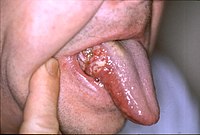
Photo from wikipedia
This study aimed to assess the ability of dental students and recent graduates to detect and recognize mucosal changes that are suggestive of oral cancer and potentially malignant disorders. In… Click to show full abstract
This study aimed to assess the ability of dental students and recent graduates to detect and recognize mucosal changes that are suggestive of oral cancer and potentially malignant disorders. In this cross-sectional study, a questionnaire was administered to dental students and recent graduates of Ajman University (n = 132). Completed questionnaires were received from 84 (63.6%) females and 48 (36.4%) males which included fifth-year students (n = 80), interns (n = 39), and dental practitioners (n = 13). This questionnaire was designed to assess the respondent’s ability to detect and recognize different types of oral lesions, as well as their knowledge of oral cancer appearance and malignancy potential. The overall accuracy of diagnosis was 46%. The participants correctly identified normal variations, benign tumors, malignant tumors, and premalignant lesions at rates of 60.3%, 31.0%, 55.7%, and 33.4%, respectively. There was no significant difference between the two genders in their ability to recognize and detect correct answers (females, 48.3%; males, 47.2%). According to education level, interns provided the highest percentage of correct answers (52.5%), followed by newly dental practitioners (51.9%) and fifth-year students (44.1%). Conclusion: The respondents of this survey did not exhibit a satisfactory diagnostic capability in recognizing mucosal changes consistent with the clinical presentation of oral cancer. Thus, a need exists for improved and updated educational methods for undergraduate students regarding oral cancer and potentially malignant disorders. Meanwhile, practitioners should look for oral abnormalities to provide better diagnosis and management. Practitioners should also stay up to date on the oral malignancy topic by attending workshops and clinicopathological conferences.
Journal Title: Healthcare
Year Published: 2021
Link to full text (if available)
Share on Social Media: Sign Up to like & get
recommendations!